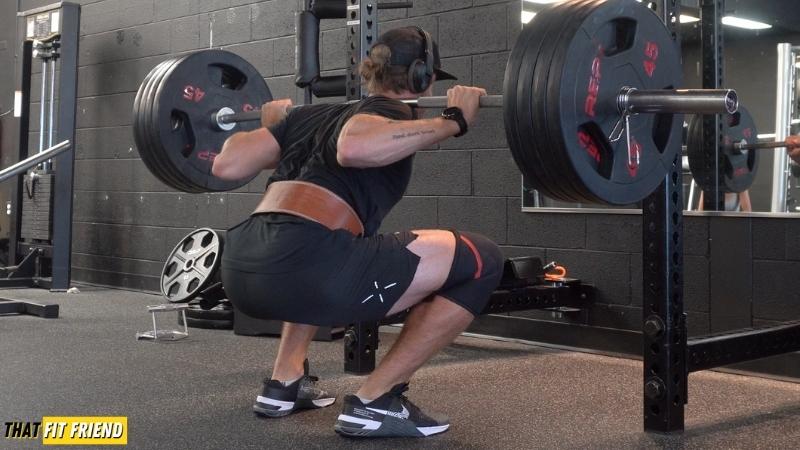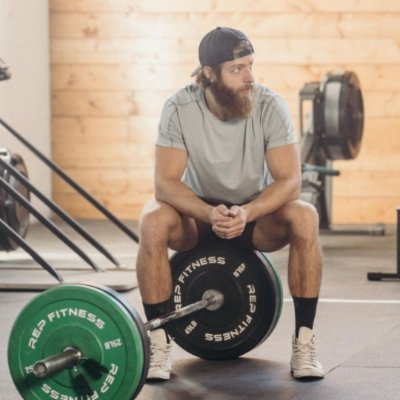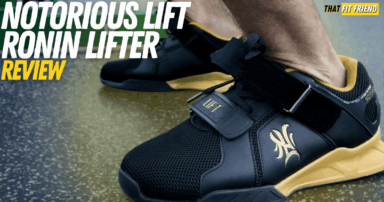Whether you’re just starting out on your cross-training journey or you are finally deciding to level up your footwear selection, you’ve likely wondered something along the lines of, “Can I just wear running shoes for cross-training?”
In this day and age, I think it’s more common to own a pair of running shoes versus a good quality pair of training shoes. While cross-training shoes are growing in popularity they’re still not a style of shoe that everyone owns.
After answering countless questions about this topic on my YouTube channel, I wanted to put together an article explaining why it’s not the best idea to use running shoes for cross-training workouts.
I’ll also provide some coaching thoughts that I share with my athletes and clients when it comes to footwear selection based on the workout and training goals at hand.

What Are Cross-Training Shoes?
Cross-training shoes are a specific type of workout shoe that is designed to accommodate a wide range of activities. In the gym, cross-training shoes can be used for things like lifting, classes, HIIT workouts, and more.
As opposed to footwear options like a running shoe or weightlifting shoe, which have very specific use cases, cross-training shoes are designed to be somewhat of a “jack-of-all-trades” style shoe.
A cross-training shoe will generally have a moderate level of midsole stability, good traction on the outsole, and an upper construction that provides a nice level of security for locking the feet down.
These construction features are all important because they help propel a cross-training shoe’s performance when tackling workouts that can vary greatly regarding training demands and exercise selection.
Is It OK to Wear Running Shoes for Cross-Training?
In general, you’ll want to pass on using your running shoe for cross-training. Running shoes will typically lack the construction features needed to promote strong performance in cross-training workouts.
For example, let’s say you’re doing a cross-training workout that has some lifting and multi-directional work programmed. A running shoe’s thicker midsole will limit how much stability you get for both of these training verticals which can hinder performance.
To elaborate on this further, I’m going to break down three reasons why running shoes can be limiting for cross-training workouts. In my opinion, it can be useful to think of your shoes as tools for accomplishing goals and tasks at hand.
1. Running Shoes Lack Stability for Cross-Training
The first — and arguably the biggest reason why you won’t want to use running shoes for cross-training — is their lack of stability. Most modern-day running shoes have thick midsoles, and beveled heels and many have a moderate level of toe spring.
In the context of running and walking, these can be useful construction features for making running shoes more comfortable and performance-focused for their intended purpose AKA running.
However, for cross-training, these running shoe features can actually take away from a running shoe’s performance. For example, a thick foam midsole can lead to instability when lifting weights.
If you have a cross-training workout that is built primarily around weight training and strength is one of the workout’s main goals, then a running shoe’s midsole will often take away from your potential to build into the strength goal.
When shoes use softer and thicker foam materials, you’ll typically find that you feel unbalanced and unstable when lifting weights. It’s like standing on a thin pillow and trying to lift something heavy. This is why also using running shoes for squatting and deadlifting isn’t a good idea.
A running shoe’s toe spring can also be a limiter regarding stability in cross-training workouts. Toe spring entails how much a shoe’s toe is angled upwards. This is a feature that is utilized to give a shoe a more comfortable ride for walking and running.
For running and walking, toe spring can be a useful feature as it can help with foot turnover and create a smooth leg swing from stride to stride. However, for cross-training, toe spring can be a feature that limits your ability to stabilize and feel connected to the ground.
A great example here is a cross-training workout that involves kettlebell swings or snatches. If you’re using a running shoe with a lot of toe spring for these exercises then you may feel “forward” or that you keep losing your balance between reps as it can be more difficult to fully ground the feet.
A beveled heel will be similar to toe spring regarding how it limits a running shoe’s performance for cross-training. Beveled heels on shoes are heels that are built with a rounded-up construction. Like toe spring, this is a feature designed to increase comfort and performance for walking and running.
For cross-training workouts, beveled heels can take away from your ability to ground the entirety of the foot. Whether you’re lifting or doing dynamic work like kettlebell exercises, you’ll want more contact with the ground to increase balance and stability and a beveled heel in a running shoe can take away from this.
2. Running Shoes Upper Construction Lack Security for Cross-Training
The upper construction design and materials used in running shoes can also serve as a limiting factor for cross-training. Running and cross-training workouts will usually have significant differences in how much stress each activity puts into a shoe’s upper.
In general, running shoes will have upper constructions that are built purposely to be lightweight and breathable. They’ll utilize materials like lightweight meshes and uppers, which in general, promote overall breathability.
On top of the lighter-weight materials used, running shoe upper constructions are also usually built to accommodate stress from one style of activity, AKA moving forwards through the sagittal plane.
The uppers on running shoes are not typically to withstand the stress that you can experience and expose your shoes to during cross-training workouts. For example, the stress on your shoes from repetitive jumping and running will be very different.
Let’s say you’re tackling a cross-training workout where you’re doing a lot of box jumps and lateral agility and shuffle work. In this workout context, you’ll want an upper construction with layered materials and reinforced sidewalls.
The momentum and stress from this style of workout will be a lot more demanding on the upper materials than if you’re doing a steady-state run. The last thing you want is the upper of your shoes ripping or stretching prematurely during a cross-training workout.
A lot of times we overlook the upper construction used in the shoes we use for working out, but in many ways, companies work to “get ahead” of issues before they arise.
For cross-training shoes, upper constructions come in the form of being built with reinforced layers that are designed to last longer for varied workouts. A running shoe’s upper construction will lack the long-term durability and security needed for most cross-training sessions.
3. Running Shoe Outsoles Can Lack Traction
The final reason why running shoes can lack when performing cross-training workouts is due to their outsole constructions. The outsole is the bottom of the shoe and is often built with different types of rubber and tread patterns.
Running shoe outsoles will typically be built to limit overall shoe weight and provide a traction pattern to support running and walking. Typically, tread patterns will follow a pattern that supports momentum and grip when moving forward.
On top of having tread patterns built specifically for running, running shoes can have exposed foam on different parts of the shoe. This is done to limit the materials used and bring down a shoe’s overall weight as rubber can be a heavier material for a shoe.
Cross-training shoes will usually have nearly full or full rubber outsoles that are built with tread patterns that will vary grip in different directions. You’ll usually have different patterns around the forefoot, midfoot, and heel, or one consistent pattern that runs a little more aggressively in nature.
These varied tread patterns can then assist and promote better grip with forward, backward, and lateral movement. This is useful because you’ll be less prone to slippage issues when doing different cross-training workouts.
Now, it’s worth noting that some cross-training shoes do have exposed foam layers on the outsole and you’ll want to consider the types of surfaces you’re training on as this can more or less matter based on your needs.
For example, if you’re regularly training on wooden floors doing classes or on turf, you’ll want to make sure you’re grabbing a shoe with a rubber outsole construction because foam could lead to slip issues. If you’re training on rubber gym floors, then this won’t matter to the same degree.
Much like everything in life, nuances matter, so it’s important to consider the context of your training and needs when looking into different cross-training shoes. Like running shoes, they’ll have subtle differences that will help more or less excel for your needs.
Choosing Between Cross-Training Shoes and Running Shoes
In my coaching opinion, it’s a good idea to invest in both types of footwear. By doing so, you’ll actually, and ironically, prolong your investment because you’ll be using the shoes for their intended purposes which can prolong a shoe’s durability.
Think of shoes as tools and a means to an end to accomplishing a job at hand. Why force something to work like using a running shoe for a cross-training workout, especially if your goal is to perform at your highest level?
If you’ve already invested in cross-training shoes and running shoes and you’re still confused about when to use each, then I’d suggest looking at your workout in a range of specificity.
On one side of the range, you’ll have running, and on the other, cross-training. Based on the contents and context of your workout, select where on that range of specificity you’ll be landing for the day.
For example, if your workout is primarily running with a little conditioning at the end with some core work and bodyweight exercises, then you’ll likely want to opt for running shoes as the majority of your will cater to that style of footwear.
Suppose your workout entails primarily lifting and jumping with some shorter running (think, under 3 miles). In that case, you’ll want to opt for cross-training shoes as the majority of the work you’ll be performing will resonate best with a cross-training shoe’s construction.
For classes, HIIT workouts, and everything that exists in the middle between these two sides, I’d suggest experimenting with different footwear to see what allows you to perform your best.
There really isn’t a “right” or “wrong” in this context, there are just “better” and “sub-par” options regarding footwear. If you prefer to use running shoes for these styles of workouts and you don’t notice your performance dropoff, then proceed.
At the end of the day, your performance and comfort preferences should take the lead regarding footwear selection as these two factors can heavily dictate performance output and workout adherence, which are king and queen for progress.
Frequently Asked Questions (FAQ)
Q:Is It OK to Wear Running Shoes for Cross-Training?
Q:Is It OK to Wear Running Shoes for CrossFit?
Takeaway Thoughts
It can be useful to think about shoes as tools for accomplishing the job at hand. Running shoes and cross-training shoes are built differently for specific reasons, much like how a hammer and screwdriver are built for accomplishing different tasks.
While you can technically use running shoes for cross-training, their use will typically come with some drawbacks. For example, a running shoe’s construction will typically take away from your potential for performance output during cross-training workouts.
If you have additional questions about finding the perfect running shoes and cross-training shoes for your individual training style, drop a comment below or reach out to me on Instagram (@jake_boly or @that_fit_friend) and I can help you out.






















John Burdick
I think in addition to asking what activity mix is intended, the question of why a person is considering the question of running shoes matters.
When running shoes reviewers dismiss a shoe as useless, they will sometimes say the shoe is adequate for casual use or maybe the gym. I have running shoes that have low, firm mid-soles; heavy out-soles with good quality rubber; or heavy, structured uppers. Many modern runners would call them bad shoes.
Some of the more agile training shoes may be fine for running compared to those disfavored running shoes. On one extreme barefoot road running shoes, barefoot trail running shoes, and barefoot gym shoes are more similar to each other than the high stack versions. If the desire to use running shoes is for the light, cushioned, and propulsive feel anything near a potential middle ground won’t provide that.
For concerns of buying multiple pairs of top name shoes, I like that you include reviews of shoes for more reasonable prices. And agree with consideration of wear from reliance on one pair.
Man, I have the best community in the world. Really appreciate you taking the time to read this one and share additional thoughts on it. I feel like we could make an hour-long podcast talking about the nuances and exceptions here!
Thank you, John!